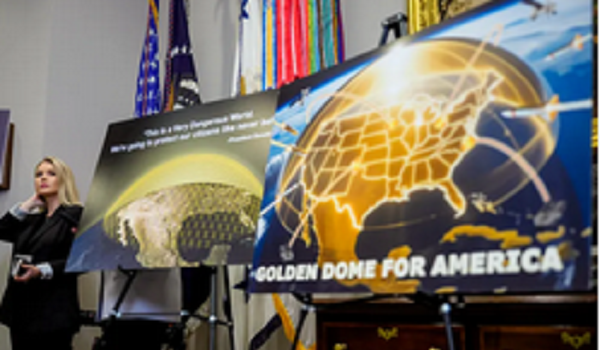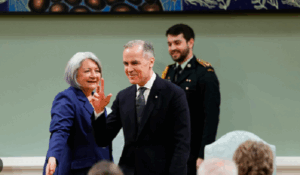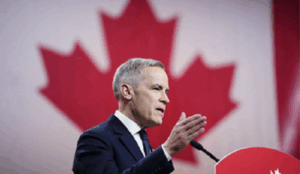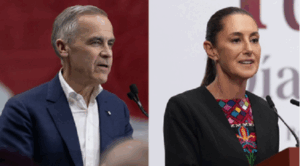‘We clearly need to be more proactive’: Carney defends Golden Dome talks with U.S., says missile threats are serious
Mark Carney on Wednesday talked up the benefits of participating in a “Golden Dome” missile shield with the United States and defended what would be deeper military co-operation despite his election campaign message about a cooling relationship with Washington.
The Prime Minister, however, remained non-committal on whether Canada would ultimately sign up for the defence shield and declined to discuss what price tag Ottawa would face if it did so.
Mr. Carney said co-operation with the United States will take place only when it‘s advantageous to Canada.
“We are in a position now where we co-operate when necessary, but not necessarily co-operate,” he said, adding later, “When it is in Canada’s first best interest to co-operate with the Americans,” his government will embrace that option.
Golden Dome is the White House’s plan for a US$171-billion system to expand continental defences against missile and drone attacks. U.S. President Donald Trump touched off speculation over Canada’s potential role in the system Tuesday when he said Mr. Carney’s government had called and asked to join.
Mr. Carney spoke to reporters after a two-day cabinet retreat where he and his ministers mapped out the new government‘s first few months.
He said the recently announced fall budget would include “new commitments on defence investment” as the Prime Minister fulfills a campaign promise to accelerate reaching NATO’s target of 2 per cent of GDP for military spending − a threshold that will require $20-billion more in annual spending to achieve.
Partnering with Mr. Trump on Golden Dome could end up increasing Mr. Carney’s plans for military spending.
The Prime Minister said Canada faces threats from missile attacks including some that in the “not-too-distant future could come from space.”
The joint Canada-U.S. North American Aerospace Defence Command (NORAD) is currently upgrading radar systems to detect incoming threats. The Prime Minister said Canada must be able to take action once missiles are spotted.
“We clearly need to be more proactive because from the time you see a missile, there’s not much time,” Mr. Carney said.
If a missile is detected, he said, Canada has to take action rather than just warning Canadians that they only have 30 seconds before it hits.
Asked for his assessment of Golden Dome, he replied: “Is it a good idea for Canada? Yes, it‘s a good idea to have protection against missiles in place for Canadians,” he said.
He said Ottawa must also consider whether it wants to be left out of decision-making over military action by the United States that could affect Canada.
“Is Canada going to be doing this alone or with the United States? Because with a Golden Dome, there will be decisions that could have an impact on Canada, but Canada wouldn‘t be a part of them.”
Mr. Carney said he has talked to Mr. Trump about joining the Golden Dome program but suggested that what is transpiring are not negotiations but rather “military decisions” on what is best for Canada.
Mr. Carney during his recent election campaign talked about placing more distance between Canada and the United States after Mr. Trump’s threats to annex this country, and his continuing protectionist tariffs.
Canada risks downgrading the role it plays in the defence of North America if it takes a pass on joining the Golden Dome missile shield, a defence expert said.
David Perry, president of the Canadian Global Affairs Institute, a think tank, said Mr. Trump’s plan appears to be integrating a range of different systems that could defend against threats from ballistic, cruise and hypersonic missiles, using ground-based stations, launches from ships and even space-based interceptors.
He warned that Canada could also be left vulnerable to missiles if it remains outside the shield when the U.S. is scrambling resources to intercept incoming threats.
In order to join Golden Dome, Ottawa would have to abandon its official policy since 2005 of not joining a U.S. program to intercept ballistic missiles. Critics back then had warned that it could lead to a new arms race, and Ottawa at the time cited the Americans’ refusal to promise that the plan would not lead to the placement of weapons in space.
Mr. Perry said Canada’s 2005 decision meant that U.S. Northern Command, not NORAD, took over responsibility for ballistic-missile defence in the years that followed.
“Right now, we have an odd dynamic where NORAD is involved in the defence of North America, except for the defence against one particularly significant threat of ballistic-missile attack,” Mr. Perry said.
CTV News reported Wednesday that U.S. ambassador to Canada Pete Hoekstra warned that it would jeopardize the NORAD alliance if Canada backed away from a plan to purchase U.S.-made F-35 fighter jets.
Mr. Carney, whose government is reviewing whether to scale back its F-35 buy, said interoperability is one of the factors that is being considered as part of the rethink. He said Canada has European alternatives for fighter-jet purchases and his government must weigh which is in the best interests of Canada.
Joining Golden Dome would be a natural evolution of the modernization of NORAD that Canada and the United States are already undertaking, said Philippe Lagassé, a Carleton University associate professor whose research areas include defence policy and procurement.
Canada has already committed more than $38-billion over 20 years to upgrade the command’s ability to detect and track new missile threats. This includes a new “Northern Approaches” surveillance system being set up as the U.S. grapples with how to respond to Russian and Chinese hypersonic missiles, which can change course in flight, as well as advanced cruise missiles with improved stealth capabilities.
“If the Trump administration sees this as the continuation of NORAD, or in some way parallel to it, and if we want to maintain that binational command relationship … then it makes sense that we’re trying to get involved with the continuation of that, or the extension of that,” Prof. Lagassé said.
Mr. Perry said he finds it hard to imagine that a Golden Dome shield could expect to protect North America from thousands of Russian missiles, adding that it makes more sense that a system could protect the continent from a limited attack from North Korea or Iran.
“Depending on exactly what‘s deployed and how extensive it is, it would provide a reasonable level of assurance that a country like Iran, which has both drone and missile capabilities, couldn‘t do something that would get past current air and missile-defence systems.”
Derek Holt, head of capital markets economics at Bank of Nova Scotia, warned in a note to clients Wednesday that the cost for Mr. Trump’s missile-defence shield could be much higher − and the delivery schedule far longer.
Citing a May, 2025 U.S. Congressional Budget Office report, Mr. Holt noted that the federal agency’s estimates to deploy a constellation of space-based interceptors to block one or two intercontinental ballistic missiles fired at the United States by a regional adversary, such as North Korea, would run from US$161-billion to as high as US$542-billion.
Mr. Trump has said Canada would pay its fair share. But extending the shield to cover Canadian territory could further drive up the overall price tag, Mr. Holt noted.
The Scotiabank economist said it may be justified if this ends the trade war Mr. Trump launched – but acknowledged the U.S. President could always produce another demand later.
“If it‘s a blackmail payment to encourage the U.S. to drop tariffs in exchange for buying more defence goodies from the U.S., then maybe it could be worth it given the longer-run damage tariffs would do. Until the next blackmail.”
This article was first reported by The Globe and Mail















